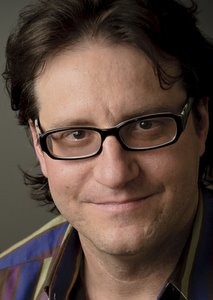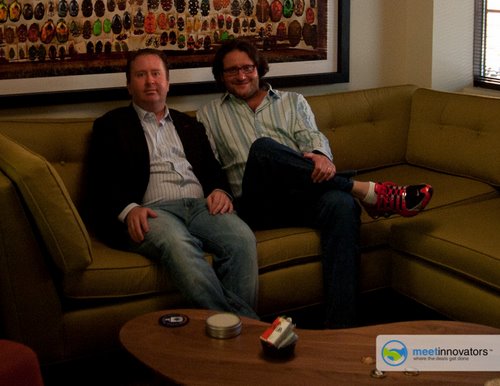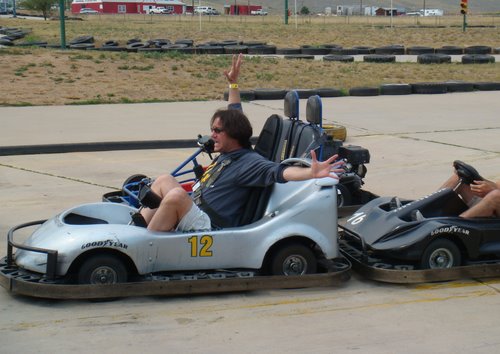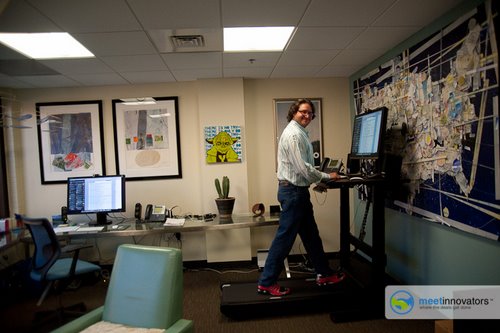- Learn How Venture Capitalist Brad Feld Thinks About YCombinator And The Angel Business
- Why Brad Feld’s Wife Told Him He Was Bad To Live With-How He Fixed It And What You Can Learn
- What Assistance Do Foundry Group Portfolio Companies Actually Get?
Full Interview Audio and Transcript

Personal Info
Sports Teams: none
Favourite Books:
- Zen and the Art of Motorcycle Maintenance: An Inquiry into Values by Robert M. Pirsig
- Atlas Shrugged by Ayn Rand
- Snow Crash by Neal Stephenson
Favourite Entrepreneurs: Young first time entrepreneurs in who he sees himself from his 20’s
Twitter: http://twitter.com/bfeld
Personal Blog: http://feld.com
Company Website: http://www.foundrygroup.com
Interview Highlights
This is a condensed audio transcript. The full source audio is provided if needed. The interviewee may post corrections in the comments.
Adrian Bye: Today I’m sitting here with Brad Feld, who is one of the partners in the Foundry Group. So Brad, tell me a little bit about who you are and where you’ve come from and what you want to be when you’re a big boy.
Brad Feld: I’ve lived in Boulder since 1995, so I’ve been here for 15 years. I started life as an entrepreneur. I started my first company when I was 19, at MIT, when I was an undergrad there. It was self-funded. We raised 10 bucks, because that’s what we had, and built a business over seven years that we sold to a public company, my partner and I. I spent a couple years working for that public company as they grew. They were ultimately acquired by GE Capital, for about a half a billion dollars. So it was very interesting to be part of my small success and then part of their big success.
During that period of time, ’94 to ’96, I started making angel investments with my own money, made about 40 angel investments, a lot of early Internet-related companies, east coast and west coast, companies like NetGenesis and Critical Path and Harmonix, that all went on to big success.
In ’96, I joined up with three other guys and we started a venture firm that started off with SoftBank venture capital, that was affiliated with SoftBank, and evolved into Mobius Venture Capital. Same business, but just different name. And then, in 2006, with my other three partners, started Foundry Group. And the four of us continue to manage all the old Mobius funds. So there’s still a very active number of companies, probably about 40 companies or so, in the old Mobius Venture Capital fund.
So I’ve sort of gone through this evolution, from entrepreneur to angel investor to venture capital investor, and have been involved in lots of interesting things away, like TechStars, which I helped start in 2006 with David Cohen.
Adrian Bye: Cool. Can you talk about the deal size on your sale?
Brad Feld: Sure. My first company, we sold it for a couple million bucks. Some cash, some stock. And stock was in a public company. That public company went on to increase in value a fair amount and then pulled back, and then ultimately GE bought the company. So the end result, to me, was a modest amount of millions of dollars.
Adrian Bye: It was a good start from there.
Brad Feld: Yeah. I was 28. It gave me enough money. I then turned around and reinvested most of that money in startups. So, many of the companies that I invested in between ’94 and ’96 with my own money, much of that money that I made from selling my first company, and a number of those companies ended up being extremely successful from a financial perspective. So it was a good object lesson in taking 10 bucks, turning it into, through a lot of hard work as an entrepreneur, a million or two, and then, from that, turning that into some real wealth through some smart investing.
Adrian Bye: That’s impressive. Something I’m really interested in, because you’ve gone through, you’ve had a successful exit, but then you went straight into investing. Why did you choose that path rather than saying, “Well, now I’ve made some money and I’m going to go and start a bigger thing”?
Brad Feld: The time frame that I was investing, from ’94 to ’96, the first year and a half of it I was working full-time for the company that bought mine, which was Ameridata. So I started off. They bought my business. We created their consulting practice. We doubled our business in about nine months, just based off of the growth that they had and some easy business that came our way.
And then the parent company, Ameridata, bought a $20-million business that looked like ours and we merged our piece into it. And at that point, I stopped having any sort of line responsibility for managing the consulting business, and as part of that, I was starting to invest my own money. So I was in this phase where I was essentially working full-time for this very rapidly growing public company, and I was making angel investments while I was doing that.
I was pretty active with some of these companies as chairman, but not a full-time employee. I never took a salary from any of them, didn’t work for them. And I really never liked managing a business. I was always medium-bored with being a CEO. And as I was investing as an angel, what I started realizing was I really enjoyed helping create the companies and working with a CEO who wanted to be the CEO of a 1,000-person company.
Adrian Bye: OK. So let me ask. I’m curious. You’ve seen all of those roles. You’ve gone from being entrepreneur to being acquired, to angel to VC. I’ve noticed that a lot of people do that: they move to being a VC. Is it just more fun being a VC than it is being an entrepreneur?
Brad Feld: No. In fact, I think a lot of operational executives who become VCs, who then suck at being VCs, end up going back to being operational executives. I think that it’s a different thing.
If you ask me the question, “What’s exciting to me?” what’s exciting to me is the essence of creating companies. I decided a long time that, professionally, I would spend the balance of my active professional life helping entrepreneurs create companies. We have a lot of deeply held beliefs that allow us to then focus our energy on the thing that we’re really passionate about, rather than get confused about where should we spending our time and what should we be doing.
Adrian Bye: That’s interesting. I’m interested in your thoughts on angel investing. Do you do any angel investing?
Brad Feld: Well, I have. I’ve probably made about 75 angel investments, in two periods: the ’94 to ’96 period and then the 2006-2007 period. I don’t make angel investments now. We do seed investments at Foundry, so we do plenty of investments that look like the same thing.
Adrian Bye: That’s what I’m really curious about. You’re doing smaller-size investments that are like angel investments.
Brad Feld: Well, you have to define it carefully. So, small-size investment for us is a $250,000 to $1 million investment. So, yes, we do lots of seed investments. Probably about a third of the investments we made out of the fund were investments like that.
In a seed investor, we’re usually either half the syndicate–we do it with one other venture firm–or we do it ourselves and we do it with angels following on alongside, because we’re perfectly happy to work with angels. But we’re not making a large number of small-dollar investments. We’re really treating our seed investments the same way we treat any other investment. It just happens to be at the very early part of the cycle, where we’re investing a small amount of capital.
I’m obviously very supportive. And I say “I” but myself and my partners are very supportive of all the angel-investing activity, through TechStars. That dynamic there obviously has a very strong angel component to it. We love angel investors as co-investors, so we welcome them and have really good relationships with them. And we’ve collectively and individually invested in a bunch of the super-angel funds that have emerged. I would say some because we think the people are extraordinary, and some because we want to support more activity in that area.
Adrian Bye: There’s a bit of a dynamic. This is news-related, so if you’re listening to this in the future then this will have changed, but I’m going to talk about what’s pretty current right now. The dynamic between Y Combinator. And so, basically systematizing what angels are doing, and then angels getting more access to the early deals, and then angels wanting to grow and become VCs, which is exactly what you’ve done, and making things more competitive.
Some people might think that the angels can disrupt the VCs and basically grow and just take over the deals themselves. Others might say that the Y Combinators and TechStars of the world can displace the angels, because they’re systematizing the early stage stuff and then also making the deals more expensive. What’s your opinion on all of that?
Brad Feld: I actually think the debate’s kind of all bullshit. The ecosystem of entrepreneurship, the focus of entrepreneurship, should be on the entrepreneurs, not on the investors. The battle lines that get drawn, especially by people in the media who want to create conflict to make it more interesting — or some of the actors. There may be the case that there are some VCs who are trying to draw some battle lines or some angels who are trying to draw some battle lines.
I think that’s very short-sighted thinking on their part if anybody’s actually doing that because, frankly, first of all, they need each other and, more importantly, they’re not the thing that matters. The thing that matters is the entrepreneur. The entrepreneurs think that category of investor is shitty, the world’s going to know that and the other great entrepreneurs are going to know that and that category of investor, that specific investor, is going to be not part of the ecosystem anymore.
Adrian Bye: I’m interested to know, realistically, what does a portfolio company get from you? How many portfolio companies do you have right now?
Brad Feld: We have, in the fund that we raised in 2007 – it’s a $225 million fund – we have about 30 investments in the fund. The range of capital we invest in a company is typically between $5 and $15 million over the life of the company. Our first investment could be as small as a quarter of a million or half a million dollars. Our largest first investment that we’ve made to date is $8 million.
Adrian Bye: What is typical assistance? You talked about instead of you trying to figure out what they wanted, you let them request things of you. So what types of things do entrepreneurs want?
Brad Feld: Well, it varies a lot. Part of the engaged dynamic between an entrepreneur and investor, where there’s real engagement, is that there’s a relationship that’s developed that’s substantial. For example, I’m on the board of a company called NewsGator, which is a Mobius investment.
I had dinner, last night, with the CEO, J.B. Holston and J.B. and I have developed a very – we’ve worked together now for five, six years. NewsGator’s doing extremely well. We get together once a quarter for dinner and we’ve just decided that’s a good rhythm for the two of us. He travels a lot. He’s very busy running a business. It’s growing. But we like to spend time with each other and to have a two-hour dinner, three-hour dinner once a quarter – is a very comfortable rhythm.
We don’t meet face to face throughout the year other than that, but we always have a nice, quarterly evening. That quarterly evening, we cover a lot of business stuff – sort of what’s going on now. But we spend most of our energy talking about what’s going forward. So we have a quarterly rhythm of looking forward together in the context of that. We have regular board meetings. We email all the time. So there’s tons of interaction, but the physical interaction is very segmented.
That’s a different physical interaction, for example, than other companies that we have in our portfolio. Just give another example which would be a company like Standing Cloud where the CEO and I, Dave Jilk, were also very good friends. Dave was my partner in my first business. We’ve had a very long-standing relationship. But he and I get together, from a business perspective, roughly once a week. I’d like to say we probably do two or three times a month.
So it’s not that I wait for the CEO, necessarily, to reach out to me. It’s that I’m very aware that each entrepreneur has a different cadence and a different set of things they need help with and want help with. My job is to adapt to them rather than to impose some structure on them.
Adrian Bye: Very interesting. I want to ask you, lastly, about TechStars. Tell us a little bit about it.
Brad Feld: So, I co-founded TechStars with David Cohen who’s the CEO and two other guys, David Brown and Jared Polis. The four of us started it together in 2006. The goal of the program is to help first-time entrepreneurs. Other things that have come out of it, David and I wrote a book called “Do More Faster,” which is available – obviously you can buy it online at Amazon or Barnes & Noble. The publication date is October 4th. It’s supposed to be in stores around the U.S. October 20th. It’s written by us and many of the TechStars entrepreneurs and mentors. So we have about 80 chapters.
Adrian Bye: Eighty chapters?
Brad Feld: Yeah. Small. Two, three page chapters organized into seven themes. In each theme is a section. So I guess each theme is a chapter and within each chapters there are these little two, three page vignettes – some written by us, some written by mentors, some written by entrepreneurs that talk about the process of early-stage entrepreneurship and are very experiential. It’s not prognosticating advice. It’s real examples of experiences people have had within their lessons and advice on top of it.
We tried to pick something that first-time entrepreneurs could really relate to and immerse themselves in. Also, at the same time, each of the short vignettes stand on their own. So if you’re looking for information about fundraising, there’s a chapter on fundraising. If you’re looking for information about product, there’s a chapter on product. There’s just a lot of information through there.
Adrian Bye: What’s your favorite part of the book?
Brad Feld: The last theme of the seven is “Work/Life Balance” and I’ve heard, over and over again, that this debate about should work/life balance even be part of the discussion around entrepreneurship and entrepreneurs shouldn’t have work/life balance. You should just be completely obsessed.
It took me until I was 30 to get to the point where I had to figure something out and really until I was probably 35 before I was motivated to figure something out. So I moved to Boulder in 1995 – was kind of the first step and in 2000 Amy basically told me she was done. We had a long – I won’t tell the preamble to this story because it’s too long, but we get to a place for a weekend at the end of the day. We’re getting into bed and she looks at me and she says, “I’m done.”
It was a Friday night. I’m like, “Yeah, man. That was a tough week. I’m really tired.” She says, “No. No. No. I’m done. Like, I don’t want this relationship anymore. This is not – I love you. I think you’re amazing, but this is not satisfying to me.” And Amy said, “You know, you’re not even a good roommate. I could get a better roommate than you.” That was a wake-up call.
I said, “Well, alright. I’m not done. I don’t want to be done with this relationship. You’re the person I want to spend my life with. Let’s understand – I’ve got an engineer’s brain. Give me some rules. Let’s come up with some rules that will help us do that.” Ten years ago we instituted a handful of rules, that we still follow, that really create some balance.
The chapter I wrote in that section is one of those rules, which we call the “Quarterly Week Off The Grid.” Where – kind of written about on my blog – every week I give her my cell phone as we leave on vacation somewhere and at the end of the week, she gives it back to me. No email. No phone. If there’s an emergency, my assistant, Kelly, can find me. My partners know how to find me.
Interestingly, all my partners are now doing this and it’s incredible because what it does is it gives you space to really recharge your batteries and to spend time with your family. Then, also, in the back of your mind, to be processing a lot of the stuff that you need to process so that when you come back you’re really ready to go.
It’s one of multiple things that I think are very important for entrepreneurs if they want to sustain that pace over a long career. So that’s a part I’m particularly proud of in the book, but I think the whole book – the amount of material and the amount of knowledge and insight from the mentors, but especially from the first time entrepreneurs and just reading their stuff after they’ve gone through the TechStars program and been running their businesses for a year or two and just how they reflected on it.
Some of the chapters just give you chills because it’s just such powerful stuff from somebody who I knew as a newbie entrepreneur who had never really gone through anything and just a level of maturity a year or two later and the depth of their insight into what matters and what doesn’t matter is really fascinating.
Adrian Bye: Cool. Thank you, Brad.
Brad Feld: You’re welcome.









